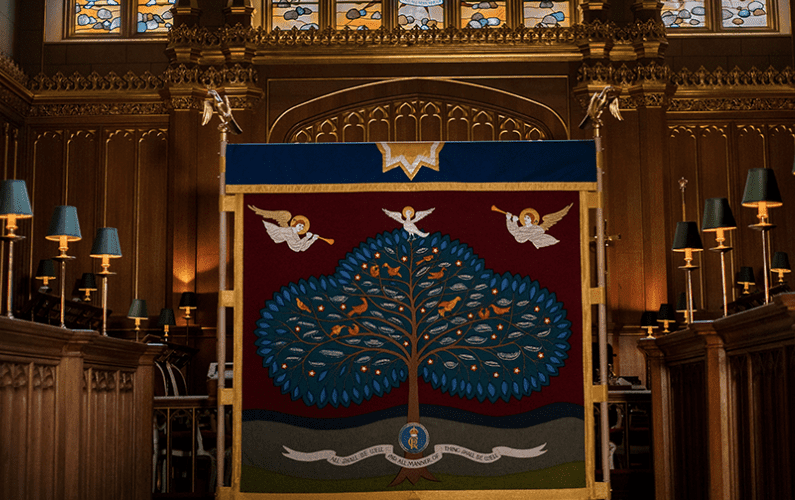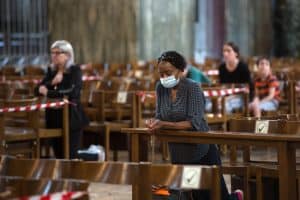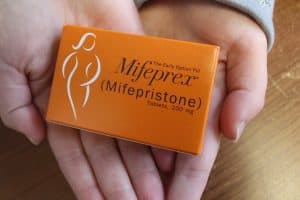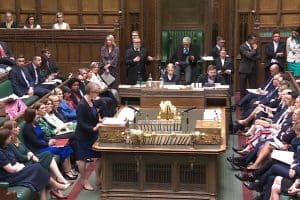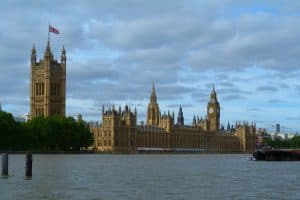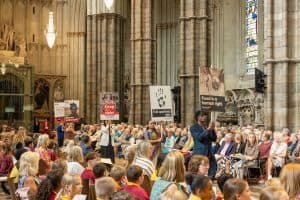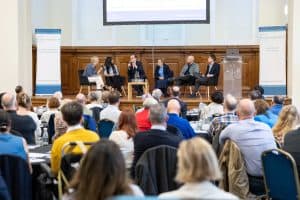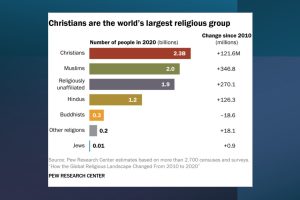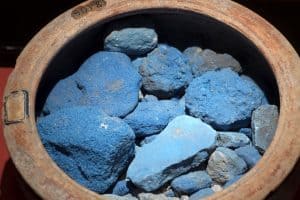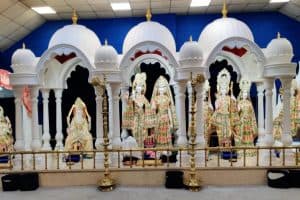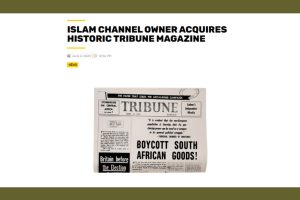By Catherine Pepinster
When the Archbishop of Canterbury, Justin Welby, begins the coronation service at Westminster Abbey on 6 May, he will start it with a reference to one of the key doctrines of Christianity: that God is three persons:
The grace of our Lord Jesus Christ, the love of God, and the fellowship of the Holy Spirit be with you
There are other three-in-ones in this coronation. There’s the team who have put this coronation service together: the Church of England, the King, and the government, particularly with reference to the constitutional elements of the service.
And then there is perhaps the most complicated three-in-one: this service looks back, because it is full of tradition; it’s the present — contemporary Britain; and it’s looking forward to what Britain might become. It’s a difficult balancing act, and we will probably only know, once the coronation is over, if they’ve managed to carry it off.
Tradition, overall, dominates, from the fact that however much there are nods to diversity, and involving other faiths and other Christian denominations, the Church of England is in the driving seat. And there are many rituals, symbols and prayers that have been used in coronations in this country over 1,000 years.
There are many nods to contemporary Britain, however, mostly through those representatives of others faiths and different Christian clerics involved; with people who are not aristocrats or bishops asked to participate in processing with parts of the coronation regalia; and the much greater number of women involved than ever before.
In 1953, a reigning was queen crowned, but she was surrounded by white men and certainly no women priests. The only other significant women in 1953 were the maids of honour, the coronation equivalent of bridesmaids. This time, three women bishops play a part.
And the service also looks to the future, with its theme of “Called to Serve”. It’s clear that the church and the King want his service to be an inspiration to others, that the country might focus more on service — something that the holiday Monday after the coronation will also be about, with its Big Help Out celebration and its invitation to people to get involved in volunteering.
Finally, there is another, unexpected look to the future. The homage of the peers, usually a feature of coronations, has been done away with and in its place is something called the homage of the people, but turns out to be an unexpected promise of allegiance. People in the abbey and at home are being invited to say: “I swear that I will pay true allegiance to Your Majesty, and to your heirs and successors according to law. So help me God.”
In a country where the majority still support the monarchy, but a sizeable minority are keen on a republic, will being asked to give allegiance to not only Charles, but to Princes William and George, going to be popular? This seems quite a gamble.
Those are the key takeaways. Here is a guide point by point to the order of service.
Processions
Before the service begins, there is a procession of faith leaders and faith representatives of the Jewish, Sunni and Shia Muslim, Sikh, Buddhist, Hindu, Jain, Baháʼí and Zoroastrian communities, plus a procession of leaders of Christian denominations, plus the flags of the 15 realms of which Charles is King.
As the King and Queen process in to the abbey, the anthem by Parry, I Was Glad, written in 1902 for the Coronation of Edward VII, with its shout of Vivat! Vivat! Vivat Rex! will be sung.
A greeting
There is a striking innovation this time, when a young chorister steps forward and welcomes the King, who answers, highlighting the coronation them of called to serve: In his name, and after his example, I come not to be served but to serve.
This is a reference to Jesus Christ and what he says in Matthew 20:28, Mark 10:45, and John 13:1-17 NIV: the Son of Man did not come to be served, but to serve, and to give his life as a ransom for many.
The Archbishop of Canterbury then offers a standard greeting, invoking the Holy Trinity and a Kyrie eleison is sung. Much of the coronation service has its roots in the Roman Catholic mass which would have framed the coronation service before the Reformation. While the old-style mass would have been said in Latin, one prayer — the Kyrie — was said in Greek, with Kyrie eleison meaning Lord have mercy — as people preparing to receive holy communion, begin with a penitential prayer, focusing on their sins and seeking forgiveness.
This Kyrie has been specially commissioned for the coronation, and although it keeps the usual title, it is sung in Welsh.
The recognition
At every coronation held in Westminster Abbey — and they have all been held here since 1066, an area called the theatre is built between the quire, where the choir sits, and the area leading to the high altar. It is where the key parts of the coronation are held — the oath-taking, the anointing, and the crowning.
But first — and this is a long-standing tradition — the monarch is presented to the people four times, to mirror the north, south, east and west points of the compass. Previously, the Archbishop of Canterbury did this. This time, he will present the King, followed by Lady Angiolini, a former Scottish Lord Advocate; Christopher Finney, GC, representing holders of the Victoria and George Cross, and Baroness Amos, a former Labour minister.
The Bible
A Bible is presented to the monarch at the coronation for two reasons: to highlight the importance of the word of God; and for the King to use as he comes to swear his oaths. The Bible will be presented by the Moderator of the Church of Scotland as it was to Elizabeth II in 1953. Back then, it was the only ecumenical gesture. It is a tradition for a Bible to be made specially for this purpose. The one made for Charles is tooled in red leather, with a floral design on its cover, symbolising the King’s interest in the natural world. The words spoken as the Bible is given emphasise how integral it is to Christianity and the basis of Judaeo-Christian culture and law-making:
Here is Wisdom; This is the royal Law; These are the lively Oracles of God. [Lively in this context means the words are alive and speak into our lives.]
The oath
This is the legislative part of the coronation service and one of the oldest and essential parts of it. This time there is one main difference: it includes introductory words from the Archbishop of Canterbury which re-assert the position of the Church of England as the established church: “The church established by law, whose settlement you will swear to maintain” and refers to its new-found justification for its existence today: “[it] will seek to foster an environment in which people of all faiths and beliefs may live freely”.
This echoes a statement made in 2012 by Elizabeth II in a ground-breaking speech when she said that “gently and assuredly, the Church of England has created an environment for other faith communities and indeed people of no faith to live freely”.
The King, who not only succeeded his mother as monarch but also as Supreme Governor of the Church of England, made similar comments at a reception for faith leaders, held a week after he acceded to the throne in September 2022, when he pledged to be a protector of faith.
Yet for all this focus on being hospitable to others, the swearing of oaths by the monarch is a moment of mutual endorsement by the King and the Church of England. It includes the King promising mercy in his judgments and to govern according to customs in his realms — and note that 70 years ago these were named; now they are not. But then it moves on, using the same legal language as 70 years ago, when the king is asked about maintaining the Protestant reformed religion and the Church of England. So, the church that later endorses the King through anointing and crowning, is endorsed by him at this stage.
The King then goes further and swears the oath under the Accession Declaration Act of 1910, which can occur at a state opening of parliament, or a coronation. After previously promising to maintain the Protestant reformed religion, this goes further, swearing that: “I am a faithful Protestant”. Before the 1910 act, the emphasis was not so much a positive endorsement of being a Protestant but a denunciation of Roman Catholicism.
After the oath, an anthem by William Byrd is sung, using words written by Thomas Cranmer, a former Archbishop of Canterbury, who joined forces with Henry VIII to enable the Protestant Reformation and was later put to death by Henry’s daughter, Mary Tudor, who as Queen tried to return England to Roman Catholicism. The words first appeared in the Book of Common Prayer, which the King is particularly fond, as he is of the King James Version of the Bible, used throughout this service.
Byrd was adept at pleasing both Catholic and Protestant as a composer and a short while later his Gloria, first used by Roman Catholics, was composed. Now it is being sung at the coronation of a monarch whose role it is to support Protestantism.
A king’s prayer
Another innovation in this coronation is the King’s prayer, which Charles will recite aloud — the first time a monarch has done this at a coronation in this country. It again refers to Christ’s dictum about serving, and not being served. He then says: “Grant that I may be a blessing to all thy children, of every faith and conviction” — another attempt in this coronation at inclusivity.
The readings
Readings from Scripture are always part of a Christian service and there are two in the Coronation Service — one from St Paul’s Epistle to the Colossians and the other from Luke’s Gospel. The two readers signify ways in which Britain has changed so much from 1953: the epistle is read by the prime minister, Rishi Sunak, the son of migrants from East Africa who were of Indian descent, and is a Hindu; and the gospel is read by Dame Sarah Mullally, the most senior woman bishop in the Church of England. Luke’s Gospel is about being called to serve, the theme of the coronation.
The sermon
It is the norm in church services for the sermon — the moment of teaching — to be conducted but coronations do not always have sermons. The Archbishop of Canterbury, Geoffrey Fisher, did not preach at the 1953 coronation and neither did Cosmo Lang in 1937 at the coronation of George VI.
Veni Creator Spiritus
This is one of the great songs of the church — although perhaps more familiar to Roman Catholics than other denominations — invoking the Holy Spirit — and often sung at occasions such as confirmations and ordinations. It has been used in coronations since the 14th century but for the first time sung in the four languages of the United Kingdom — a verse apiece in English, Welsh, Scots Gaelic and Irish Gaelic.
The anointing
This is the heart of the coronation ceremony — the most spiritual, most sacramental moment — when the King is anointed with holy oil, as a sign of God’s blessing being bestowed on him. The oil was consecrated by Hosam Naouam, the Anglican bishop in Jerusalem, who has brought it from Jerusalem where it was created and blessed by the bishop and the Greek Orthodox Patriarch of Jerusalem.
The oil has a particular resonance for the King as it was made from olives growing where his paternal grandmother, Princess Alice, is buried on the Mount of Olives in Jerusalem. Alice became a Greek Orthodox nun later in life, and her son, the Duke of Edinburgh was baptised in the Greek Orthodox Church, later joining the Church of England when he married Elizabeth II — then Princess Elizabeth — in 1947. The King has strong personal links with the Greek Orthodox Church, too, having spent several retreats at a monastery on Mount Athos, and has had Greek Orthodox music commissioned for his coronation.
Kings in this country have been anointed for more than 1,000 years, as the written record of the coronation of King Edgar in 973 shows. Its roots are in the Bible and since the time of King Edgar a verse from the Old Testament First Book of Kings is said as the monarch is anointed. In 1727 Handel composed an anthem with these words for the coronation of George II and has been used at every crowning since. It will be sung on 6 May as the King makes his way to the ancient coronation chair where he will be first anointed and then crowned:
Zadok the Priest and Nathan the Prophet anointed Solomon king. And all the people rejoiced.
This is the most intimate moment of the coronation service — a moment, says Welby, when the King comes face to face with the King of Kings (meaning Jesus Christ). The oil will be poured from a vessel called the ampulla, which is in the shape of an eagle, and the oil will come through its beak into the medieval coronation spoon, the oldest item in the coronation regalia. The archbishop will anoint the King, who will have been divested of his robes and will wear a simple white shirt, on his head, palms and breast, hidden from view behind a screen made for this service. At previous ceremonies the monarch was hidden by a canopy. Neither the congregation in the abbey, except a few clerics, nor those watching on TV, will be able to see it.
Coronation chair
The chair, dating from 1296, when it was made by Edward I to house the Stone of Scone, also known as the Stone of Destiny, that he plundered from the Scots, and has been used for every crowning since then. The stone was returned to the Scots in 1996 and for the first time since then it has been sent back to the abbey for the coronation.
Vesting
After the anointing, the King is prepared for his coronation. The man who was blessed is now “converted” into a monarch in all his grandeur, with special clothing akin to that of a priest, including a supertunica (gold coat), a robe and a specially commissioned stole. Then come a series of items which the King holds so that finally, after the crown in put on his head, he is seen in all his pomp.
Regalia presentation
This ceremony will be a mix of old and new, with some senior Anglican bishops involved, together with people following in their ancestors’ footsteps who performed the same ritual, plus representatives of contemporary British society. Among them will be a Hindu, Sikh, Muslim and Jewish peer, but it has been carefully arranged so that they do not hand over any item with a specifically Christian connection, such as the orb which is topped by a cross.
Music
Many new pieces of music have been composed for the coronation service, including a new version of Psalm 71, which will be sung during the presentation of symbolic swords to the King. The psalm will be sung as Greek Orthodox chant, which reflects the King’s heritage, through his father, the Duke of Edinburgh, and his paternal grandparents, Prince Andrew and Princess Alice of Greece.
Regalia and crowning
Among the most important items are the orb, the sceptre, and St Edward’s Crown, all made for Charles II’s coronation in 1661, after the previous regalia was destroyed on the orders of Oliver Cromwell during the English Civil War. The orb represents the earth, and Christ having dominion over all of it, including kings and queens, signified by the cross topping it. The sceptre, also topped with a gross, represents authority and good governance.
St Edward’s Crown, named after Edward the Confessor, is solid gold and weighs 2.23kg (nearly 5lb). It is only ever used at a coronation. It, too, is decorated with a cross, showing the King serves God and God’s people. As soon as he crowns the King, Archbishop Welby will say God Save the King! and the people will respond with God Save the King!
Fanfare and salute
This was the moment in 1953 when the princes, princesses, peers and peeresses put on their coronets while trumpets sounded and guns went off at the Tower of London. The flummery this time has been abandoned but the trumpets and the guns remain.
The blessing
This is the ecumenical moment in the sun for the leaders of Christian denominations. Bookended by blessings from the Archbishop of York, Stephen Cottrell, and the Archbishop of Canterbury, Justin Welby, blessings are said in turn by: Nikitas Loulias, the Greek Orthodox Archbishop of Thyateira & Great Britain; the Rev Helen Cameron, Moderator of the Free Churches; Bishop Mike Royal, general secretary of Churches Together in England; and Cardinal Vincent Nichols, the Roman Catholic Archbishop of Westminster. Between them, their prayers add up to about 90 words — a minute amount compared with the thousands in this coronation. Ecumenical involvement was well-publicised in advance but remains limited.
Enthroning
This moment, often called inthroning in previous coronations, involves clerics setting the King in his throne. In 1953, the moment was described as lifting Elizabeth II into her throne but this is more likely to be holding the King by the elbows. The Archbishop of Canterbury will say a prayer beginning “Stand firm”, although the King is not sitting but standing, but the phrase here means be a beacon of stability.
Homage
This is one of the reimagined moments of the coronation. At previous ceremonies, including the 1953 coronation, this was a moment for royalty and aristocracy to pay homage to the newly crowned sovereign. This has been abandoned. In 1953, the first to pay homage was the Archbishop of Canterbury and Elizabeth II’s husband, the Duke of Edinburgh. This time, it will be the Archbishop of Canterbury and Prince William, who has succeeded his father as Prince of Wales. During the Archbishop of Canterbury’s homage, he will use the King’s title, Defender of the Faith, one of two mentions of it in the service.
There will be homage by the bishops of the Church of England, but only from the few involved in the coronation service. The rest of the Anglican bishops will be at home in their dioceses.
Then comes an innovation: the Homage of the People, when Archbishop Welby will invite people in the abbey and at home to say:
I swear that I will pay true allegiance to Your Majesty, and to your heirs and successors according to law. So help me God.
Coronation of the Queen
Queen Camilla will be the first Queen Consort to be crowned since Queen Elizabeth, later the Queen Mother, in 1937. She will be crowned with the coronation crown of Queen Mary, which will not include the Koh-i-Noor diamond — now linked to colonialism — but several diamonds cut from the huge Cullinan Diamond. A jewel from that diamond is also set in the sceptre used by the King.
There will also be an anointing service but only of her head and not behind a screen. Camilla will also have her own robes and regalia, including a sceptre and rod and a ring.
As Queen Camilla is enthroned beside her husband, the moment, says Archbishop Welby, is about their joint vocation of service. An anthem, specially composed by Andrew Lloyd Webber, will be played. It is a setting of Psalm 98, Make a Joyful Noise unto the Lord.
Communion service
Attention now switches to the communion service, with gifts of bread and wine brought to the altar. The communion, or eucharist, service commemorates the last supper of Jesus with his disciples the night before his crucifixion. The Gospels record that he said to them: Do this in memory of me. Holy communion is the central part of services of most Christian denominations. Others place more emphasis on the word of God, with readings from the Bible.
Two pieces of music are sung at this part of the communion service, which reflect traditional prayers of the Roman Catholic mass and high Anglican services: the Sanctus, before the consecration of the bread and wine, and the Agnus Dei, after the consecration. Both are new commissions and both in English: the Sanctus, written by Roxanna Panufnik, and the Agnus Dei by Tarik O’Regan.
Also, before communion, the Lord’s Prayer — the most famous Christian prayer, based on words Jesus was recorded as saying when his followers asked him how to pray — is said, with Archbishop Welby asking people, wherever they may be, to say it in their own languages.
Only the King and Queen and the clergy receive communion during this service — offering it to everybody would hours to the proceedings.
End of the service
The service ends with a blessing, a sung Amen, and one of the most popular English hymns, Praise My Soul, The King of Heaven.
Te Deum
Te Deums have been part of the church from the fourth century and are sung at moments of great rejoicing. They are frequently sung at coronations, although not always at the end. At this coronation, it will be sung while the King and Queen slip into something more comfortable — changing, in St Edward’s Chapel, behind the high altar, into simpler robes, and the King swaps the heavy St Edward’s Crown for the lighter Imperial State Crown, recognisable from state openings of parliament. This one was first made for the coronation of his grandfather, George VI, in 1937.
National Anthem
This is sung when the King and Queen re-emerge.
Greeting from faith leaders
The King has always been keen to involve leaders of other faiths in his coronation but doing so proved a difficult matter to negotiate — so delicate that Lambeth Palace has stressed that the greeting happens outside the religious service while still part of the ceremonial. The needs of other faiths had to be respected too, especially that the coronation takes place during the Orthodox Jewish Shabbat.
The faith leaders and representatives taking part are:
Chief Rabbi Sir Ephraim Mirvis (Judaism)
The Most Venerable Bogoda Seelawimala (Buddhism)
The Rt Hon the Lord Singh of Wimbledon (Sikhism)
Radha Mohan Das (Hinduism)
Aliya Azam (Islam)
Departure
The King and Queen depart in the Gold Coach for a procession back to Buckingham Palace.
Catherine Pepinster is the author of Defenders of the Faith: the British Monarchy, Religion and the Coronation, published by Hodder and Stoughton.

